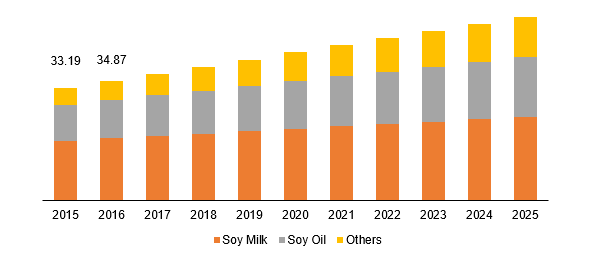
Soy Food Market Size And Forecast, By Product (Milk, Oil, Others), By Application (Food and Beverages, Feed, Pharma) And Trend Analysis, 2015 - 2025
- Published: January, 2019
- Format: Electronic (PDF)
- Number of pages: 90
- Industry: Food & Beverages
Industry Insights
The global soy food market revenue was USD 36.67 billion in 2017 and is expected to reach USD 56.66 billion by 2025. Market growth is primarily driven by growing health awareness among consumers due to high nutritional value. Lactose intolerance is increasing in individuals worldwide especially in places such as U.S., Asia, Europe. This is expected to promote the use of these products as an alternate to lactose based products.
With an aim to cater to the shifting preference, manufacturers are introducing flavor induced products to make them more appealing among consumers. For example, WhiteWave Services, Inc. have introduced eight different flavors of milk in order to cater to wide customer base.
Global soy food market revenue by product, 2015 - 2025 (USD Billion)

Soy also know as soya is expected to witness high demand due to the increased vegan population globally. Increasing preference towards plant based protein as compared to animal based protein is expected to augment the demand for these products in the near future. As of 2018, over one fourth of the American population consumed soy beverages or foods once a week or more.
In 2010, the same stood at over 20.0%, which indicated an increasing trend towards consumption in the region. According to certain research studies, the consumption of fortified products is the highest during dinner as compared to any other meal.
Segmentation by Product
• Milk
• Oil
• Others (Nut, Sauce, Fragrance and Others)
The milk segment was valued at USD 2.67 billion in 2017 and is projected to reach USD 4.08 billion by 2025. It is the largest and fastest growing segment of the market.
Soya milk contains low sugar in comparison to cow milk which has increased its adoption rate globally. In addition, it is endowed with additional protein, fiber and omega 3 fatty acids. Raw materials required for preparation of non-dairy milk are easily available which is likely to stimulate soya food market growth over the coming years.
Major milk producers are investing heavily in soy milk production thereby catering to the change in consumer preference for plant-based milk. For instance, in 2016, French milk producer Danone acquired WhiteWave Foods Inc. for USD 10 billion, in order to enter the soy milk market. In addition, they can also cater to the U.S. food market, as population in the U.S. are more lactose intolerant as compared to France.
Segmentation by Application
• Food and Beverages
• Feed
• Pharma
Food and beverage application segment held a majority share in the global soy food market as of 2017. It was valued at USD 19.10 billion in the same year and is expected to reach USD 29.36 billion by 2025. Manufacturers are rapidly introducing new products in the market to meet changing consumer needs. In the beverage segment, manufacturers are using soya protein isolates such as protein drinks, yogurt, and smoothies.
Food manufacturers are increasing their product line for soy foods to ensure sustainability in the competitive environment. For instance, in April 2014, French food manufacturer Laboratoire PYC introduced a product line of protein-filled dietetic crisps that instantly became popular in North America and Europe.
Segmentation by region
• North America
• Europe
• Asia Pacific
• Central and South America
• Middle East and Africa
Asia Pacific contributes majorly to the global soya food market, accounting for a share of 40.0% in 2017 and is expected to grow at a CAGR of 5.9% from 2017 to 2025. Demand for soy based milk, oil and sauce in countries such as China, Indonesia and India is significantly higher than western countries. However, the increase in disposable income coupled with growing awareness towards health benefits of food and beverage products are likely to drive the demand in the region.
Europe is the largest imported for the raw material with Germany having the highest number of production facilities. They majorly import from Brazil and the U.S. Germany was the largest consumers in Europe followed by France with the U.K. being estimated to be the fastest growing market over the forecast period.
China is one of the largest manufacturers and importers of soya food. Due to changes in the U.S. trade policy, China is attempting to decrease their consumption over the next decade. In 2017, China accounted for over 60.0% of the total Asia Pacific consumption. The country is expected to grow at a CAGR of .4.3% over the forecast period.
In 2017, the U.S. soy food market was estimated to have a value of USD 5.02 billion and it is expected to reach USD 8.07 billion by 2025. Over the past few years, the U.S. has become one of the major producers of soybeans and nearly half of the total production is processed domestically for oil and milk. It is estimated that the sale of soy based spreads and creams is significantly lower as compared to oils and milk.
Competitive Landscape
Some of the major manufacturers include Archer Daniels Midland, Cargill, Hain Celestial, Miracle Soybean Food International Corp., Nordic Soy Oy, Freedom Food Group, and Victoria Group. The market possesses a huge growth potential and manufacturers are focusing on offering a wide product portfolio to gain competitive advantage and share.
A few milk producers are acquiring food businesses to enter into the soy food industry. For instance, in 2018 Chicago based Archer Daniels Midland Co. acquired a Russian company, Aston to increase its production of vegetable oil.

Choose License Type
- World's largest premium report database
- Transparent pre & post sale customer engagement model
- Unparalleled flexibility in terms of rendering services
- Safe & secure web experience
- 24*5 Research support service
